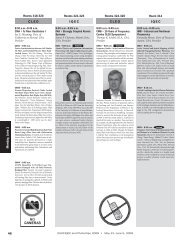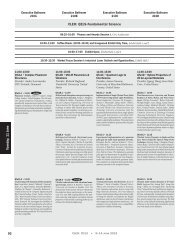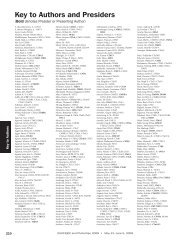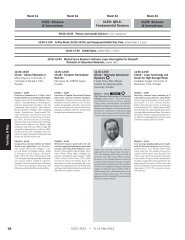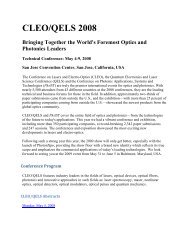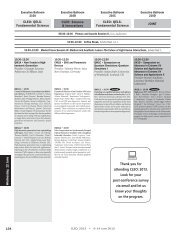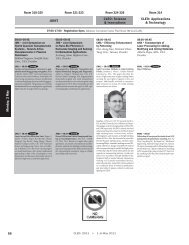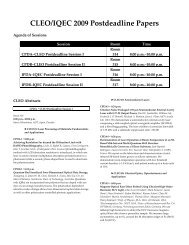Tuesday, 3 May 2011 - CLEO
Tuesday, 3 May 2011 - CLEO
Tuesday, 3 May 2011 - CLEO
Create successful ePaper yourself
Turn your PDF publications into a flip-book with our unique Google optimized e-Paper software.
Room 318-320 Room 321-323 Room 324-326 Room 314<br />
<strong>CLEO</strong>: QELS-<br />
Fundamental Science<br />
<strong>CLEO</strong>: Science<br />
& Innovations<br />
JOINT<br />
11:00–12:45<br />
QTuE • Plasmonic Optical<br />
Devices<br />
Presider to Be Announced<br />
11:00–12:45<br />
QTuF • Frequency Combs<br />
and Carrier-Envelope Phase<br />
Phenomena<br />
Mark Foster, The Johns Hopkins<br />
Univ., USA, Presider<br />
11:00–12:45<br />
CTuG • Semiconductor<br />
Nanolasers<br />
Seth Bank, Univ. of Texas, USA,<br />
Presider<br />
11:00–12:45<br />
JTuC • Joint Symposium on<br />
Quantum Communications II:<br />
Networks<br />
Thomas Chapuran, Telcordia,<br />
USA, Presider<br />
QTuE1 • 11:00 Invited<br />
Optical Trapping at the Ultimate Nanoscale in<br />
the Near-field of Plasmonic Antennas, Olivier J.<br />
Martin 1 ; 1 Nanophotonics & Metrology Lab, Swiss<br />
Fed. Inst. Technology, Switzerland. We study the<br />
trapping of nanoscopic objects in the near-field<br />
of plasmonic nanostructures and demonstrate<br />
experimentally that 10nm particles can be trapped<br />
in the 15nm gap of a dipole antenna. Applications<br />
for biosensing are discussed.<br />
QTuF1 • 11:00<br />
Frequency Comb Generation in Crystalline<br />
MgF 2 Whispering-Gallery Mode Resonators,<br />
Tobias Herr 1 , Christine Wang 2 , Pascal Del’Haye 2 ,<br />
Albert Schliesser 1,2 , Klaus Hartinger 1,3 , Ronald<br />
Holzwarth 2,3 , Tobias Kippenberg 1,2 ; 1 LPQM, EPFL,<br />
Switzerland; 2 MPQ, Germany; 3 Menlo Systems<br />
GmbH, Germany. We demonstrate frequency<br />
comb generation via four-wave-mixing in crystalline<br />
MgF 2 whispering-gallery mode resonators.<br />
More than 800 comb lines spaced by 43 GHz are<br />
observed. Second order autocorrelation is performed<br />
for time-domain characterization.<br />
CTuG1 • 11:00 Tutorial<br />
Nanoscale Lasers: How small can they go Shun<br />
L. Chuang 1 ; 1 Electrical and Computer Engineering,<br />
Univ. of Illinois at Urbana-Champaign, USA.<br />
Recent progress in both theory and experiment<br />
of nanoscale lasers will be presented. We will<br />
discuss metal-cavity nanolasers, their designs and<br />
performances, and how our theory explains the<br />
experimental data with a good agreement.<br />
JTuC1 • 11:00 Invited<br />
Tokyo QKD Network and the evolution to<br />
Secure Photonic Network, Masahide Sasaki 1 ;<br />
1<br />
Quantum ICT Group, National Inst. of Information<br />
and Communications Technology, Japan. A novel<br />
secure communication network with quantum key<br />
distribution in a metropolitan area is reported. Different<br />
QKD schemes are integrated to demonstrate<br />
secure TV conferencing over a distance 45km, key<br />
relay, and so on.<br />
<strong>Tuesday</strong>, 3 <strong>May</strong><br />
QTuE2 • 11:30<br />
An Integrated Plasmonic Polarimeter, Farzaneh<br />
Afshinmanesh 1 , Justin S. White 1 , Wenshan Cai 1 ,<br />
Mark Brongersma 1 ; 1 Stanford Univ., USA. We<br />
present a plasmonic device that can determine<br />
the state of polarization of an incident light beam<br />
over a narrow wavelength band. The measurement<br />
results show 25 and 1.13 contrast ratio for linear<br />
and circular polarizations at 830nm.<br />
QTuF2 • 11:15<br />
Coherence properties of a mid-infrared frequency<br />
comb produced by a degenerate optical<br />
parametric oscillator, Alireza Marandi 1 ,<br />
Nick C. Leindecker 1 , Robert L. Byer 1 , Konstantin<br />
Vodopyanov 1 ; 1 Stanford Univ., USA. We show<br />
that a broadband mid-infrared frequency comb<br />
produced by a degenerate optical parametric<br />
oscillator is stable and phase locked to the pump.<br />
Moreover, the OPO can operate in two phase and<br />
two frequency states.<br />
QTuF3 • 11:30<br />
Green Enhancement Cavity for Frequency<br />
Comb Generation in the Extreme Ultraviolet,<br />
Birgitta Bernhardt 1 , Akira Ozawa 1 , Ioachim Pupeza<br />
1 , Andreas Vernaleken 1 , Yohei Kobayashi 2 ,<br />
Ronald Holzwarth 1 , Ernst Fill 1 , Ferenc Krausz 1 ,<br />
Theodor W. Hänsch 1 , Thomas Udem 1,3 ; 1 Max-<br />
Planck-Institut für Quantenoptik, Germany; 2 The<br />
Inst. for Solid State Physics, Univ. of Tokyo, Japan;<br />
3<br />
Ludwig-Maximilians-Universität, Germany. Peak<br />
intensities > 2x10 13 W/cm 2 are generated in a green<br />
enhancement cavity en route to XUV frequency<br />
comb generation with unprecedented conversion<br />
efficiencies. Enhancement limitations in the green<br />
region are discussed for the first time.<br />
Shun Lien Chuang received the Ph. D. degree<br />
in EECS from MIT in 1983. He then joined the<br />
Univ. of Illinois at Urbana-Champaign, where<br />
he is currently the MacClinchie Distinguished<br />
Professor of Electrical and Computer Engineering.<br />
His research interest is on semiconductor<br />
nanophotonic devices. He is the author of Physics<br />
of Photonic Devices (second edition, 2009) and<br />
Physics of Optoelectronic Devices (first edition,<br />
1995), Wiley. He is a Fellow of the APS, IEEE, and<br />
OSA. He received Engineering Excellence Award<br />
from OSA (2004), the IEEE/LEOS Distinguished<br />
Lecturer Award (2004-2006), the Streifer Scientific<br />
Achievement Award (2007), and the Humboldt<br />
Research Award for Senior U.S. Scientists (2008).<br />
JTuC2 • 11:30 Invited<br />
Full eavesdropping on a practical QKD system,<br />
Christian Kurtsiefer, Natl. Univ. of Singapore, Singapore.<br />
We present a successful attack on a practical<br />
QKD system based on a detector vulnerability,<br />
where 100% of the generated key is obtained without<br />
leaving traces in the error ratio between the<br />
legitimate communication partners.<br />
QTuE3 • 11:45<br />
High-throughput Fabrication of Plasmonic<br />
Nanoantenna Arrays Using Nanostencils for<br />
Spectroscopy and Biosensing, Serap Aksu 1,2 ,<br />
Ahmet Yanik 2,3 , Ronen Adato 2,3 , Alp Artar 2,3 , Min<br />
Huang 2,3 , Hatice Altug 2,3 ; 1 Materials Science and<br />
Eng., Boston Univ., USA; 2 Photonics Center, Boston<br />
Univ., USA; 3 Electrical and Computer Engineering,<br />
Boston Univ., USA. We present a novel approach<br />
for high-throughput and high-resolution fabrication<br />
of infrared nanoantenna arrays with reusable<br />
nanostencils for vibrational spectroscopy. Optical<br />
responses of these antennas are identical to ones<br />
fabricated by EBL.<br />
QTuF4 • 11:45<br />
Second-order coherence of supercontinuum,<br />
Goëry Genty 1 , Minna Surakka 2 , Jari Turunen 2 , Ari<br />
Friberg 2,3 ; 1 Tampere Univ. of Technology, Finland;<br />
2<br />
Univ. of Eastern Finland, Finland; 3 Aalto Univ.,<br />
Finland. Using second-order coherence theory<br />
of nonstationary light we show that supercontinuum<br />
can be split into quasi-coherent and<br />
quasi-stationary parts. Our results opens the route<br />
for a universal definition of the coherence degree<br />
for broadband sources.<br />
Reminder:<br />
<strong>CLEO</strong>: <strong>2011</strong> Program<br />
now available in<br />
mobile formats!<br />
<br />
Visit<br />
www.cleoconference.org<br />
for more information.<br />
96<br />
<strong>CLEO</strong>: <strong>2011</strong> • 1–6 <strong>May</strong> <strong>2011</strong>



